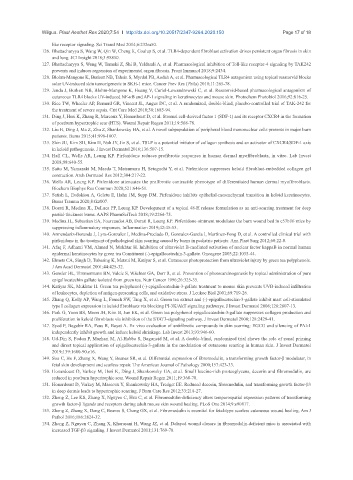Page 638 - Read Online
P. 638
Wilgus. Plast Aesthet Res 2020;7:54 I http://dx.doi.org/10.20517/2347-9264.2020.150 Page 17 of 18
like receptor signaling. Sci Transl Med 2014;6:232ra50.
126. Bhattacharyya S, Wang W, Qin W, Cheng K, Coulup S, et al. TLR4-dependent fibroblast activation drives persistent organ fibrosis in skin
and lung. JCI Insight 2018;3:98850.
127. Bhattacharyya S, Wang W, Tamaki Z, Shi B, Yeldandi A, et al. Pharmacological inhibition of Toll-like receptor-4 signaling by TAK242
prevents and induces regression of experimental organ fibrosis. Front Immunol 2018;9:2434.
128. Blohm-Mangone K, Burkett NB, Tahsin S, Myrdal PB, Aodah A, et al. Pharmacological TLR4 antagonism using topical resatorvid blocks
solar UV-induced skin tumorigenesis in SKH-1 mice. Cancer Prev Res (Phila) 2018;11:265-78.
129. Janda J, Burkett NB, Blohm-Mangone K, Huang V, Curiel-Lewandrowski C, et al. Resatorvid-based pharmacological antagonism of
cutaneous TLR4 blocks UV-induced NF-κB and AP-1 signaling in keratinocytes and mouse skin. Photochem Photobiol 2016;92:816-25.
130. Rice TW, Wheeler AP, Bernard GR, Vincent JL, Angus DC, et al. A randomized, double-blind, placebo-controlled trial of TAK-242 for
the treatment of severe sepsis. Crit Care Med 2010;38:1685-94.
131. Ding J, Hori K, Zhang R, Marcoux Y, Honardoust D, et al. Stromal cell-derived factor 1 (SDF-1) and its receptor CXCR4 in the formation
of postburn hypertrophic scar (HTS). Wound Repair Regen 2011;19:568-78.
132. Liu H, Ding J, Ma Z, Zhu Z, Shankowsky HA, et al. A novel subpopulation of peripheral blood mononuclear cells presents in major burn
patients. Burns 2015;41:998-1007.
133. Shin JU, Kim SH, Kim H, Noh JY, Jin S, et al. TSLP is a potential initiator of collagen synthesis and an activator of CXCR4/SDF-1 axis
in keloid pathogenesis. J Invest Dermatol 2016;136:507-15.
134. Hall CL, Wells AR, Leung KP. Pirfenidone reduces profibrotic responses in human dermal myofibroblasts, in vitro. Lab Invest
2018;98:640-55.
135. Saito M, Yamazaki M, Maeda T, Matsumura H, Setoguchi Y, et al. Pirfenidone suppresses keloid fibroblast-embedded collagen gel
contraction. Arch Dermatol Res 2012;304:217-22.
136. Wells AR, Leung KP. Pirfenidone attenuates the profibrotic contractile phenotype of differentiated human dermal myofibroblasts.
Biochem Biophys Res Commun 2020;521:646-51.
137. Satish L, Evdokiou A, Geletu E, Hahn JM, Supp DM. Pirfenidone inhibits epithelial-mesenchymal transition in keloid keratinocytes.
Burns Trauma 2020;8:tkz007.
138. Dorati R, Medina JL, DeLuca PP, Leung KP. Development of a topical 48-H release formulation as an anti-scarring treatment for deep
partial-thickness burns. AAPS PharmSciTech 2018;19:2264-75.
139. Medina JL, Sebastian EA, Fourcaudot AB, Dorati R, Leung KP. Pirfenidone ointment modulates the burn wound bed in c57bl/6 mice by
suppressing inflammatory responses. Inflammation 2019;42:45-53.
140. Armendariz-Borunda J, Lyra-Gonzalez I, Medina-Preciado D, Gonzalez-García I, Martinez-Fong D, et al. A controlled clinical trial with
pirfenidone in the treatment of pathological skin scarring caused by burns in pediatric patients. Ann Plast Surg 2012;68:22-8.
141. Afaq F, Adhami VM, Ahmad N, Mukhtar H. Inhibition of ultraviolet B-mediated activation of nuclear factor kappaB in normal human
epidermal keratinocytes by green tea Constituent (-)-epigallocatechin-3-gallate. Oncogene 2003;22:1035-44.
142. Elmets CA, Singh D, Tubesing K, Matsui M, Katiyar S, et al. Cutaneous photoprotection from ultraviolet injury by green tea polyphenols.
J Am Acad Dermatol 2001;44:425-32.
143. Gensler HL, Timmermann BN, Valcic S, Wächter GA, Dorr R, et al. Prevention of photocarcinogenesis by topical administration of pure
epigallocatechin gallate isolated from green tea. Nutr Cancer 1996;26:325-35.
144. Katiyar SK, Mukhtar H. Green tea polyphenol (-)-epigallocatechin-3-gallate treatment to mouse skin prevents UVB-induced infiltration
of leukocytes, depletion of antigen-presenting cells, and oxidative stress. J Leukoc Biol 2001;69:719-26.
145. Zhang Q, Kelly AP, Wang L, French SW, Tang X, et al. Green tea extract and (-)-epigallocatechin-3-gallate inhibit mast cell-stimulated
type I collagen expression in keloid fibroblasts via blocking PI-3K/AkT signaling pathways. J Invest Dermatol 2006;126:2607-13.
146. Park G, Yoon BS, Moon JH, Kim B, Jun EK, et al. Green tea polyphenol epigallocatechin-3-gallate suppresses collagen production and
proliferation in keloid fibroblasts via inhibition of the STAT3-signaling pathway. J Invest Dermatol 2008;128:2429-41.
147. Syed F, Bagabir RA, Paus R, Bayat A. Ex vivo evaluation of antifibrotic compounds in skin scarring: EGCG and silencing of PAI-1
independently inhibit growth and induce keloid shrinkage. Lab Invest 2013;93:946-60.
148. Ud-Din S, Foden P, Mazhari M, Al-Habba S, Baguneid M, et al. A double-blind, randomized trial shows the role of zonal priming
and direct topical application of epigallocatechin-3-gallate in the modulation of cutaneous scarring in human skin. J Invest Dermatol
2019;139:1680-90.e16.
149. Soo C, Hu F, Zhang X, Wang Y, Beanes SR, et al. Differential expression of fibromodulin, a transforming growth factor-β modulator, in
fetal skin development and scarless repair. The American Journal of Pathology 2000;157:423-33.
150. Honardoust D, Varkey M, Hori K, Ding J, Shankowsky HA, et al. Small leucine-rich proteoglycans, decorin and fibromodulin, are
reduced in postburn hypertrophic scar. Wound Repair Regen 2011;19:368-78.
151. Honardoust D, Varkey M, Marcoux Y, Shankowsky HA, Tredget EE. Reduced decorin, fibromodulin, and transforming growth factor-β3
in deep dermis leads to hypertrophic scarring. J Burn Care Res 2012;33:218-27.
152. Zheng Z, Lee KS, Zhang X, Nguyen C, Hsu C, et al. Fibromodulin-deficiency alters temporospatial expression patterns of transforming
growth factor-β ligands and receptors during adult mouse skin wound healing. PLoS One 2014;9:e90817.
153. Zheng Z, Zhang X, Dang C, Beanes S, Chang GX, et al. Fibromodulin is essential for fetal-type scarless cutaneous wound healing. Am J
Pathol 2016;186:2824-32.
154. Zheng Z, Nguyen C, Zhang X, Khorasani H, Wang JZ, et al. Delayed wound closure in fibromodulin-deficient mice is associated with
increased TGF-β3 signaling. J Invest Dermatol 2011;131:769-78.

